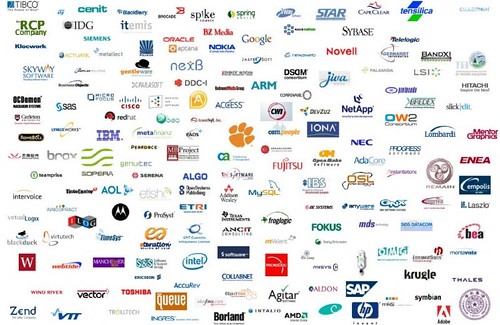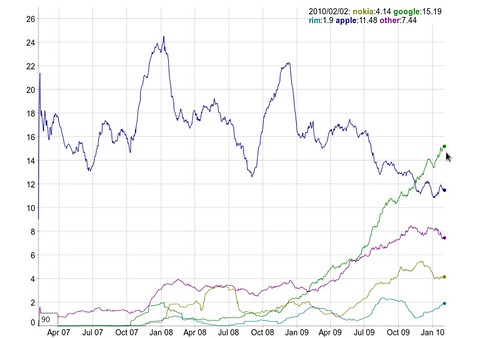Updated: added other examples from WebKit, IGEL and RIM
Yes, it may be a surprise, but that’s the beauty of Open Source – you never know where your contributions will be found. In this regard, I received a gentle mention from my friend Felipe Ortega of the Libresoft group of a nice snippet of research from Luis Canas Diaz, “Brief study of the Android community“. Luis studied the contributions to the Android code base, and splitted the contributions using the email of the originator, assigning those with “google.com” or “android.com” as internal, and classifying the others. Here is a sample of the results:
| # Commits | Domain |
|---|---|
| 69297 | google.com |
| 22786 | android.com |
| 8815 | (NULL) |
| 1000 | gmail.com |
| 762 | nokia.com |
| 576 | motorola.com |
| 485 | myriadgroup.com |
| 470 | sekiwake.mtv.corp.google.com |
| 422 | holtmann.org |
| 335 | src.gnome.org |
| 298 | openbossa.org |
| 243 | sonyericsson.com |
| 152 | intel.com |
Luis added: “Having a look at the name of the domains, it is very surprising that Nokia is one of the most active contributors. This is a real paradox, the company that states that Android is its main competition helps it!. One of the effects of using libre software licenses for your work is that even your competition can use your code, currently there are Nokia commits in the following repositories:
git://android.git.kernel.org/platform/external/dbus
git://android.git.kernel.org/platform/external/bluetooth/bluez”
In fact, it was Nokia participation in Maemo (and later Meego) and its funding of the dbus and bluez extensions that were later taken up by Google for Android. Intrigued by this result, I made a little experiment: I cloned the full Android gingerbread GIT repo (2.3), separated the parts that are coming from preexisting projects like the Linux kernel and the various external dependencies (many tens of project – included, to my surprise, a full Quake source code…) leaving for example Chromium but removing WebKit. I then took apart the external projects, and counted Google contributions there in an approximate way, and folded back everything. You get a rough size of 1.1GB of source code directly developed or contributed by Google, which means that around 75% of the source code of Android comes from external projects. Not bad, in terms of savings.
Update: many people commented on the strangeness of having fierce competitors working together in ways that are somehow “friendly” towards a common goal. Some of my twitter followers also found the percentage of 75% of non-Google contributions to be high, and this update is meant to be an answer for both. First of all, there is quite a long history of competitors working together in open source communities; the following sample of Eclipse contributors provide an intial demonstration of that:
But there are many other examples as well. WebKit, theweb rendering component used in basically all the mobile platforms (except Windows Mobile) and on the desktop within Chrome and Safari was originally developed by the KDE free software community, taken by Apple and more recently co-developed by Nokia, Samsung, RIM and Google:
And on WebKit page, it is possible to find the following list:
“KDE: KDE is an open source desktop environment and application development framework. The project to develop this software is an informal association. WebKit was originally created based on code from KDE’s KHTML and KJS libraries. Although the code has been extensively reworked since then, this provided the basic groundwork and seed code for the project. Many KDE contributors have also contributed to WebKit since it became an independent project, with plans that it would be used in KDE as well. This has included work on initially developing the Qt port, as well as developing the original code (KSVG2) that provides WebKit’s SVG support, and subsequent maintenance of that code.
Apple: Apple employees have contributed the majority of work on WebKit since it became an independent project. Apple uses WebKit for Safari on Mac OS X, iPhone and Windows; on the former two it is also a system framework and used by many other applications. Apple’s contribution has included extensive work on standards compliance, Web compatibility, performance, security, robustness, testing infrastructure and development of major new features.
Collabora: Collabora has worked on several improvements to the Qt and GTK+ ports since 2007, including NPAPI plugins support, and general API design and implementation. Collabora currently supports the development of the GTK+ port, its adoption by GNOME projects such as Empathy, and promotes its usage in several client projects.
Nokia: Nokia’s involvement with the WebKit project started with a port to the S60 platform for mobile devices. The S60 port exists in a branch of the public WebKit repository along with various changes to better support mobile devices. To date it has not been merged to the mainline. However, a few changes did make it in, including support for CSS queries. In 2008, Nokia acquired Trolltech. Trolltech has an extensive history of WebKit contributions, most notably the Qt port.
Google: Google employees have contributed code to WebKit as part of work on Chrome and Android, both originally secret projects. This has included work on portability, bug fixes, security improvements, and various other contributions.
Torch Mobile: Torch Mobile uses WebKit in the Iris Browser, and has contributed significantly to WebKit along the way. This has included portability work, bug fixes, and improvements to better support mobile devices. Torch Mobile has ported WebKit to Windows CE/Mobile, other undisclosed platforms, and maintains the QtWebKit git repository. Several long-time KHTML and WebKit contributors are employed by Torch Mobile.
Nuanti: Nuanti engineers contribute to WebCore, JavaScriptCore and in particular develop the WebKit GTK+ port. This work includes porting to new mobile and embedded platforms, addition of features and integration with mobile and desktop technologies in the GNOME stack. Nuanti believes that working within the framework of the webkit.org version control and bug tracking services is the best way of moving the project forward as a whole.
Igalia: Igalia is a free software consultancy company employing several core developers of the GTK+ port, with contributions including bugfixing, performance, accessibility, API design and many major features. It also provides various parts of the needed infrastructure for its day to day functioning, and is involved in the spread of WebKit among its clients and in the GNOME ecosystem, for example leading the transition of the Epiphany web browser to WebKit.
Company 100: Company 100 has contributed code to WebKit as part of work on Dorothy Browser since 2009. This work includes portability, performance, bug fixes, improvements to support mobile and embedded devices. Company 100 has ported WebKit to BREW MP and other mobile platforms.
University of Szeged: The Department of Software Engineering at the University of Szeged, Hungary started to work on WebKit in mid 2008. The first major contribution was the ARMv5 port of the JavaScript JIT engine. Since then, several other areas of WebKit have been tackled: memory allocation, parsers, regular expressions, SVG. Currently, the Department is maintaining the official Qt build bots and the Qt early warning system.
Samsung: Samsung has contributed code to WebKit EFL (Enlightenment Foundation Libraries) especially in the area of bug fixes, HTML5, EFL WebView, etc. Samsung is maintaining the official Efl build bots and the EFL early warning system.”
So, we see fierce competitors (Apple, Nokia, Google, Samsung) co-operating in a project that is clearly of interest for all of them. In a previous post I made a similar analysis for IGEL (popular developers of thin clients) and HP/Palm:
“The actual results are:
- Total published source code (without modifications) for IGEL: 1.9GB in 181 packages; total amount of patch code: 51MB in 167 files (the remaining files are not modified). Average patch size: 305KB, Patch percentage on total publisheed code: 2.68%
- Total published source code (without modifications) for Palm: 1.2GB in 106 packages; total amount of patch code: 55MB in 83 files (the remaining files are not modified). Average patch size: 664KB, Patch percentage on total published code: 4.58%
If we add the proprietary parts and the code modified we end up in the same approximate range found in the Maemo study, that is around 10% to 15% of code that is either proprietary or modified OSS directly developed by the company. IGEL reused more than 50 million lines of code, modified or developed around 1.3 million lines of code. …. Open Source allows to create a derived product (in both case of substantial complexity) reducing the cost of development to 1/20, the time to market to 1/4, the total staff necessary to more than 1/4, and in general reduce the cost of maintaining the product after delivery. I believe that it would be difficult, for anyone producing software today, to ignore this kind of results.”
This is the real end result: it would be extremely difficult for companies to compete without the added advantage of Open Source. It is simply anti-economic to try to do everything from scratch, while competing companies work together on non-differentiating elements; for this reason it should not be considered a strange fact that Nokia is an important contributor to Google Android.


#1 by Alex - April 24th, 2011 at 09:59
Work smarter, not harder.
#2 by Michael Chen - April 24th, 2011 at 16:19
If what you said is true, that means that Nokia spent a lot of resources which they don’t really care (they turned to Windows Phone later)
#3 by Liang Qi - April 25th, 2011 at 12:09
openbossa.org aslo could be considered Nokia.
http://web.openbossa.org/about
#4 by Dave Nattriss - April 25th, 2011 at 17:48
How does less than 1% of the commits make “Nokia one of the most active”?!